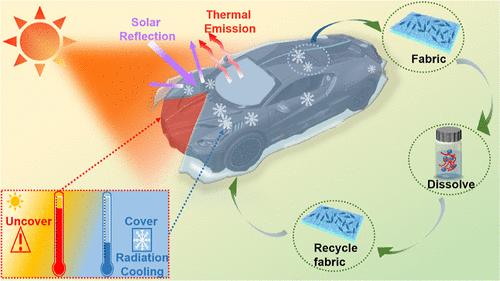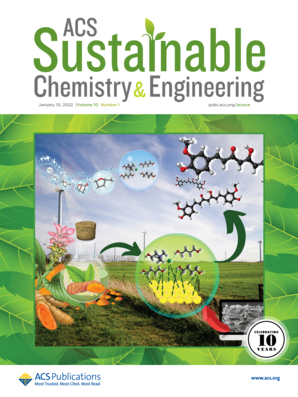Recyclable Bead Chain Structure of Ta2O5/TPU Fiber Films for Energy Harvesting and Passive Daytime Radiative Cooling
IF 7.3
1区 化学
Q1 CHEMISTRY, MULTIDISCIPLINARY
引用次数: 0
Abstract
Efficient energy acquisition and energy-saving measures are important to meet climate change commitments and address energy crises. However, combining high energy density, low preparation energy consumption, and low temperature management energy consumption remains a major challenge. We mitigate this challenge by fabricating a recyclable fiber film via the coelectrospinning of tantalum pentoxide/thermoplastic polyurethane (Ta2O5/TPU) to integrate passive daytime radiative cooling technology into the triboelectric nanogenerator (TENG) system. Due to the high dielectric constant of Ta2O5 and special bead chain structure of the fiber film, the integrated TENG-based radiative cooling textile offers an excellent TENG output (current density ∼77 mA m–2) and passive daytime radiative cooling capability (cooling temperature ∼25 °C), as well as the ability to withstand at least 10 renewable cycles. Moreover, the composite material exhibits waterproof and wear-resistant properties. As a proof of concept, the potential applications of Ta2O5/TPU fiber films in smart car clothing for energy harvesting, cooling, shading, and scratch collision warning were demonstrated. This study contributes to the development of textiles for electricity generation and zero-energy input cooling.

用于能量收集和白天被动辐射冷却的 Ta2O5/TPU 纤维薄膜的可回收珠链结构
高效能源获取和节能措施对于履行气候变化承诺和应对能源危机非常重要。然而,如何将高能量密度、低制备能耗和低温度管理能耗结合起来仍然是一个重大挑战。我们通过五氧化二钽/热塑性聚氨酯(Ta2O5/TPU)共电纺丝制造可回收纤维膜,将被动日间辐射冷却技术集成到三电纳米发电机(TENG)系统中,从而缓解了这一挑战。由于 Ta2O5 的高介电常数和纤维膜的特殊珠链结构,基于 TENG 的集成辐射冷却纺织品具有出色的 TENG 输出(电流密度 ∼ 77 mA m-2)和日间被动辐射冷却能力(冷却温度 ∼ 25 °C),并能承受至少 10 次可再生循环。此外,这种复合材料还具有防水和耐磨的特性。作为概念验证,Ta2O5/TPU 纤维薄膜在智能车衣中的潜在应用得到了证实,可用于能量收集、冷却、遮阳和刮擦碰撞预警。这项研究有助于开发用于发电和零能耗输入冷却的纺织品。
本文章由计算机程序翻译,如有差异,请以英文原文为准。
求助全文
约1分钟内获得全文
求助全文
来源期刊

ACS Sustainable Chemistry & Engineering
CHEMISTRY, MULTIDISCIPLINARY-ENGINEERING, CHEMICAL
CiteScore
13.80
自引率
4.80%
发文量
1470
审稿时长
1.7 months
期刊介绍:
ACS Sustainable Chemistry & Engineering is a prestigious weekly peer-reviewed scientific journal published by the American Chemical Society. Dedicated to advancing the principles of green chemistry and green engineering, it covers a wide array of research topics including green chemistry, green engineering, biomass, alternative energy, and life cycle assessment.
The journal welcomes submissions in various formats, including Letters, Articles, Features, and Perspectives (Reviews), that address the challenges of sustainability in the chemical enterprise and contribute to the advancement of sustainable practices. Join us in shaping the future of sustainable chemistry and engineering.
文献相关原料
公司名称
产品信息
阿拉丁
poly(methyl methacrylate) (PMMA)
阿拉丁
PVDF
阿拉丁
Ta2O5
阿拉丁
N,N-dimethylformamide (DMF)
阿拉丁
tetrahydrofuran (THF)
阿拉丁
HCl
 求助内容:
求助内容: 应助结果提醒方式:
应助结果提醒方式:


